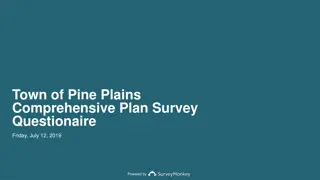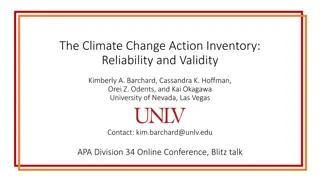Impacts of Climate Change on the Southern Great Plains Region
The Southern Great Plains region in the United States faces challenges due to climate change, including compromised quality of life, vulnerable infrastructure, altered ecosystems, and increased health threats. The increasing population, urban migration, and changing climate are redistributing demands on food, energy, and water resources. Adaptation strategies and early warning systems are crucial for managing these complex issues. Vulnerable ecosystems are being directly and indirectly affected, impacting both species and human communities. The region must focus on adaptation efforts to reduce the risks associated with climate change impacts.
Download Presentation

Please find below an Image/Link to download the presentation.
The content on the website is provided AS IS for your information and personal use only. It may not be sold, licensed, or shared on other websites without obtaining consent from the author.If you encounter any issues during the download, it is possible that the publisher has removed the file from their server.
You are allowed to download the files provided on this website for personal or commercial use, subject to the condition that they are used lawfully. All files are the property of their respective owners.
The content on the website is provided AS IS for your information and personal use only. It may not be sold, licensed, or shared on other websites without obtaining consent from the author.
E N D
Presentation Transcript
Fourth National Climate Assessment, Vol II Impacts, Risks, and Adaptation in the United States Chapter 23 | Southern Great Plains Fourth National Climate Assessment, Vol II Impacts, Risks, and Adaptation in the United States nca2018.globalchange.gov 1
Ch. 23 | Southern Great Plains Key Message #1 23 Food, Energy, and Water Resources Quality of life in the region will be compromised as increasing population, the migration of individuals from rural to urban locations, and a changing climate redistribute demand at the intersection of food consumption, energy production, and water resources. A growing number of adaptation strategies, improved climate services, and early warning decision support systems will more effectively manage the complex regional, national, and transnational issues associated with food, energy, and water. Fourth National Climate Assessment, Vol II Impacts, Risks, and Adaptation in the United States nca2018.globalchange.gov 2
Ch. 23 | Southern Great Plains Key Message #2 23 Infrastructure The built environment is vulnerable to increasing temperature, extreme precipitation, and continued sea level rise, particularly as infrastructure ages and populations shift to urban centers. Along the Texas Gulf Coast, relative sea level rise of twice the global average will put coastal infrastructure at risk. Regional adaptation efforts that harden or relocate critical infrastructure will reduce the risk of climate change impacts. Fourth National Climate Assessment, Vol II Impacts, Risks, and Adaptation in the United States nca2018.globalchange.gov 3
Ch. 23 | Southern Great Plains Key Message #3 23 Ecosystems and Ecosystem Services Terrestrial and aquatic ecosystems are being directly and indirectly altered by climate change. Some species can adapt to extreme droughts, unprecedented floods, and wildfires from a changing climate, while others cannot, resulting in significant impacts to both services and people living in these ecosystems. Landscape-scale ecological services will increase the resilience of the most vulnerable species. Fourth National Climate Assessment, Vol II Impacts, Risks, and Adaptation in the United States nca2018.globalchange.gov 4
Ch. 23 | Southern Great Plains Key Message #4 23 Human Health Health threats, including heat illness and diseases transmitted through food, water, and insects, will increase as temperature rises. Weather conditions supporting these health threats are projected to be of longer duration or occur at times of the year when these threats are not normally experienced. Extreme weather events with resultant physical injury and population displacement are also a threat. These threats are likely to increase in frequency and distribution and are likely to create significant economic burdens. Vulnerability and adaptation assessments, comprehensive response plans, seasonal health forecasts, and early warning systems can be useful adaptation strategies. Fourth National Climate Assessment, Vol II Impacts, Risks, and Adaptation in the United States nca2018.globalchange.gov 5
Ch. 23 | Southern Great Plains Key Message #5 23 Indigenous Peoples Tribal and Indigenous communities are particularly vulnerable to climate change due to water resource constraints, extreme weather events, higher temperature, and other likely public health issues. Efforts to build community resilience can be hindered by economic, political, and infrastructure limitations, but traditional knowledge and intertribal organizations provide opportunities to adapt to the potential challenges of climate change. Fourth National Climate Assessment, Vol II Impacts, Risks, and Adaptation in the United States nca2018.globalchange.gov 6
Ch. 23 | Southern Great Plains Fig. 23.1: Monitoring Precipitation Across the Southern Great Plains The Southern Great Plains is characterized by a pronounced east west gradient of precipitation, with wetter conditions prevailing to the east and arid conditions to the west. Precipitation monitoring is critical in this region; state-level Mesonet station networks in Kansas, Oklahoma, and Texas are shown here to illustrate a key aspect of current monitoring capacity. Sources: NOAA NCEI, CICS- NC, and ERT Inc. Data from PRISM Climate group, Oregon State University, http://prism.oregonstate.edu, created July 10, 2010. Fourth National Climate Assessment, Vol II Impacts, Risks, and Adaptation in the United States nca2018.globalchange.gov 7
Ch. 23 | Southern Great Plains Fig. 23.2: Hurricane Harvey Flooding Texas Army National Guard assisting in flood rescues associated with Hurricane Harvey, August 27, 2017. Photo credit: Lt. Zachary West, Texas National Guard. Fourth National Climate Assessment, Vol II Impacts, Risks, and Adaptation in the United States nca2018.globalchange.gov 8
Ch. 23 | Southern Great Plains Fig. 23.3: Hurricane Harvey Satellite Image This visible satellite image shows Hurricane Harvey approaching the Texas coast on August 25, 2017. Image credit: NASA Earth Observatory. Fourth National Climate Assessment, Vol II Impacts, Risks, and Adaptation in the United States nca2018.globalchange.gov 9
Ch. 23 | Southern Great Plains Fig. 23.4: Projected Increase in Number of Days Above 100 F Under both lower- and higher- scenario climate change projections, the number of days exceeding 100 F is projected to increase markedly across the Southern Great Plains by the end of the century (2070 2099 as compared to 1976 2005). Sources: NOAA NCEI and CICS- NC. Fourth National Climate Assessment, Vol II Impacts, Risks, and Adaptation in the United States nca2018.globalchange.gov 10
Ch. 23 | Southern Great Plains Fig. 23.5: Stock Pond Affected by Drought The photo shows the drought impact on a stock pond near Kurten, Texas, in 2011. Photo credit: John Nielson-Gammon. Fourth National Climate Assessment, Vol II Impacts, Risks, and Adaptation in the United States nca2018.globalchange.gov 11
Ch. 23 | Southern Great Plains Fig. 23.6: Highlighting Seasonal-Scale Extreme Events in a Transboundary Setting Shown here are the English- and Spanish-language versions of the February 2018 Climate Assessment for the Southwest Rio Grande-Bravo Climate Impacts and Outlook At a Glance summary. Sources: Garfin et al. 2018.44, 51 Fourth National Climate Assessment, Vol II Impacts, Risks, and Adaptation in the United States nca2018.globalchange.gov 12
Ch. 23 | Southern Great Plains Fig. 23.7: Cross Section of Edwards Aquifer Key characteristics of the Edwards Aquifer, such as relative shallowness and karst features, make it vulnerable to the impacts of both climate variability and climate change. Its importance as a major supplier of groundwater in central Texas makes these vulnerabilities even more pronounced. Source: Edwards Aquifer Authority.79Used with permission. Fourth National Climate Assessment, Vol II Impacts, Risks, and Adaptation in the United States nca2018.globalchange.gov 13
Ch. 23 | Southern Great Plains Fig. 23.8: Texas Desalination Plants Desalination activities in Texas are an important contributor to the state s efforts to meet current and projected water needs for communities, industry, and agriculture. Source: adapted from Texas Water Development Board 2017.110 Fourth National Climate Assessment, Vol II Impacts, Risks, and Adaptation in the United States nca2018.globalchange.gov 14
Ch. 23 | Southern Great Plains Fig. 23.9: Climate Winners and Losers (Gray Snapper and Southern Flounder) The graphs show trends in annual abundance of (top) gray snapper and (bottom) southern flounder as the number of fish caught per hour along the Gulf Coast of Texas between 1982 (snapper)/1983 (flounder) and 2016. As water temperatures increase along the Texas Gulf Coast, gray snapper are expanding northward along the Texas coast, while southern flounder, a popular sport fish, are becoming less abundant, impacting the recreational and commercial fishing industries. Source: Texas Parks and Wildlife Department. Fourth National Climate Assessment, Vol II Impacts, Risks, and Adaptation in the United States nca2018.globalchange.gov 15
Ch. 23 | Southern Great Plains Fig. 23.10: Cheyenne Sun Dance Ceremony Chief Gordon Yellowman is shown here representing the Cheyenne Tribe at a traditional speaking engagement. Photo courtesy of Gordon L. Yellowman, Sr. Fourth National Climate Assessment, Vol II Impacts, Risks, and Adaptation in the United States nca2018.globalchange.gov 16
Ch. 23 | Southern Great Plains Chapter Author Team 23 Esther Mullens, DOI South Central Climate Adaptation Science Center John Nielsen-Gammon, Texas A&M University Mark Shafer, NOAA-RISA Southern Climate Impacts Planning Program Cecilia Sorensen, University of Colorado Sid Sperry, Oklahoma Association of Electric Cooperatives Daniel Wildcat, Haskell Indian Nations University Jadwiga Ziolkowska, University of Oklahoma Federal Coordinating Lead Author Bill Bartush, U.S. Fish and Wildlife Service Chapter Lead Kevin Kloesel, University of Oklahoma Chapter Authors Jay Banner, University of Texas at Austin David Brown, USDA-ARS Grazinglands Research Laboratory Jay Lemery, University of Colorado Xiaomao Lin, Kansas State University Cindy Loeffler, Texas Parks and Wildlife Department Gary McManus, Oklahoma Climatological Survey Review Editor Ellu Nasser, Adaptation International Fourth National Climate Assessment, Vol II Impacts, Risks, and Adaptation in the United States nca2018.globalchange.gov 17
Ch. 23 | Southern Great Plains Acknowledgments 23 Technical Contributor Katharine Hayhoe, Texas Tech University USGCRP Coordinators Susan Aragon-Long, Senior Scientist Christopher W. Avery, Senior Manager Fourth National Climate Assessment, Vol II Impacts, Risks, and Adaptation in the United States nca2018.globalchange.gov 18
Recommended chapter citation Kloesel, K., B. Bartush, J. Banner, D. Brown, J. Lemory, X. Lin, G. McManus, E. Mullens, J. Nielsen-Gammon, M. Shafer, C. Sorenson, S. Sperry, D. Wildcat, and J. Ziolkowska, 2018: Southern Great Plains. In Impacts, Risks, and Adaptation in the United States: Fourth National Climate Assessment, Volume II [Reidmiller, D.R., C.W. Avery, D.R. Easterling, K.E. Kunkel, K.L.M. Lewis, T.K. Maycock, and B.C. Stewart (eds.)]. U.S. Global Change Research Program, Washington, DC, USA. doi: 10.7930/NCA4.2018.CH23 Read the full chapter https://nca2018.globalchange.gov/chapter/southern-great-plains nca2018.globalchange.gov Fourth National Climate Assessment, Vol II Impacts, Risks, and Adaptation in the United States nca2018.globalchange.gov 19























